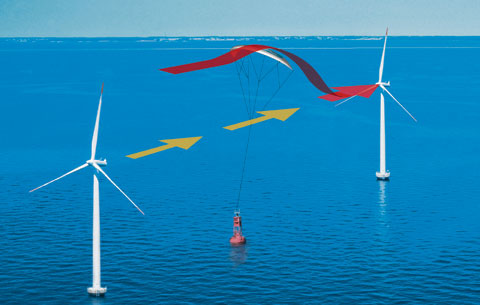Wind turbines could do with some more fresh air. Huge kites hovering in the skies above could deliver that to them. This anyway is the idea put forward by a group of BSc students at the faculty of Aerospace Engineering who came up with this concept as part of their final BSc project.
As wind turbines extract energy from the wind, they leave behind a turbulent flow of air with decreased velocity for the next turbines in the park. This so-called ‘wake’ leads to a substantial decrease in energy output.
“The decrease amounts to up to 7 percent for the wind farm off the coast at Egmond aan Zee,” says Roelant Kalthof. He and his fellow students used that wind farm with 36 turbines as a case study.
According to the students’ calculations, 23 kites with wingspans of 16 meters positioned above the wind farm at an altitude of 145 meters will bend the air towards the turbines and reduce the wake effect by 65 percent. Kalthof: “This means that the wind farm at Egmond aan Zee can produce an extra thirteen and a half thousand megawatt hours per year.”
The kites should be attached to buoys positioned in between the turbines. A control pod, positioned between each kite and the buoy, receives gps signals from a gps device in the kite, which the pod then uses to steer the kite in the right direction.
“The hardest part of the theoretical work was to calculate the effects of the kites, since the shapes of the kites change continuously due to the wind,” Kalthof explains. “To verify the results, tests should be done with a scale model in a wind tunnel.”
As far as Kalthof can surmise, he and his colleagues are the first to investigate this option of using kites to reduce the wake effect in wind farms. “Researchers from the University of Colorado and the National Oceanic and Atmospheric Administration are also looking into ways of solving the wake problem, but they are focussing on other techniques.”
Another way for instance of dealing with the wake is to create convection by heating up the air with mirrors that reflect the sun light. Convection would also result in a fresh air supply for the turbines.
Wind energy expert, Michiel Zaayer (AE), says the students’ idea is original and well thought out. Still, he is sceptical: “A 65 percent reduction seems a lot. It would surprise me if they could achieve that much. The operational part isn’t trivial, either. It’s technically very difficult to have kites in the air at all times.”
The copy service which dr. Ellis van den Hende contracted to print her thesis prints both novels and theses on a daily basis. But printing a thesis that looked like a novel confused them. “I studied the use of storytelling as a means of communicating entirely new product ideas to a consumer audience”, says Van den Hende (Industrial Design). “It turns out that telling a story about the product as if it already exists is a very effective way to make people more open to new product ideas. In fact, I rediscovered the potential of the oldest medium for communicating the newest product ideas.
Dr. Ellis van den Hende: ‘Really new stories’, ISBN 978-90-8570-578-9, obtained her doctorate cum laude on 9 July 2010.



Comments are closed.